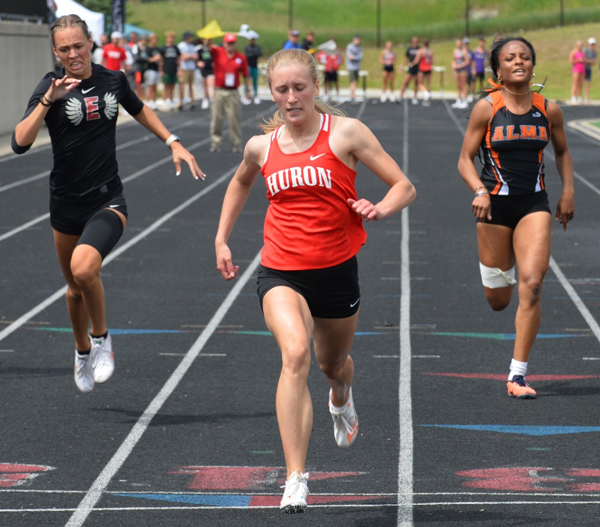
Bark River-Harris Grows Team, Gains 1st Girls Track & Field Finals Title
By
John Vrancic
Special for MHSAA.com
June 5, 2022
KINGSFORD — The Bark River-Harris girls made a statement here Saturday while earning the first Upper Peninsula track & field title in their school’s history.
BR-H, which topped the Division 2 standings with 107 points, was followed by West Iron County with 74 and Ishpeming at 60.
“This is a very big moment,” said BR-H coach Jason Lockwood. “This is something our upperclassmen started talking about at the end of last season. Last year we came here with a small team and got third. The bigger numbers this year were a major factor. We’re very strong in the sprints and sprint relays. Having that depth really helps.”
The Broncos won the 800-meter relay in a school-record 1 minute, 50.95 seconds, and freshman Julia Olson set a school record (1:01.25) while placing third in the 400.
Sophomore Mckenzie Hoffmeyer won long jump (16-1¾) for the second-straight year and took second in the 100 (13.04) and 200 (27.14). Senior Alaska Peterson added a third in the long jump (14-5½).
 Carley Varoni added a first in pole vault (8-0), and senior Aspen Fredrick gained her first U.P. 300 hurdles title at 53.57.
Carley Varoni added a first in pole vault (8-0), and senior Aspen Fredrick gained her first U.P. 300 hurdles title at 53.57.
“I had confidence in my ability to jump over the hurdles,” said Fredrick. “This is only my sixth time doing this and my first individual title. That’s what I was thinking (during the race), and that’s what kept me going.”
West Iron’s Danica Shamion repeated as champion in the 100 (12.7), 200 (26.82) and 400 (58.77), and Ishpeming sophomore Lola Korpi retained her 800 (2:36.11), 1,600 (5:42.11) and 3,200 (12:34.95) titles.
“The 1,600 went well,” she said. “I just wanted to stay in front and get as many points for our team as I could. I tried to work on picking up the pace in the second and third laps.”
In the 3,200 (which combined the D-1 and D-2 runners competing at the same time), Houghton senior Ingrid Seagren led the entire race until the final home stretch when she dropped to third overall.
“I was just planning on staying with the group I was with, and when I saw she was getting tired, I thought there was a chance,” Korpi said. “I’m proud of Ingrid, and our team for taking third place. Third is good, especially for the numbers we have.”
Iron Mountain’s Chloe Maycroft retained her high jump crown (4-11), and Manistique sophomore Danielle Lund took first in shot put (33-2) and second in discus (95-0).
Gwinn’s Lena Pleaugh and Jordana Hardy went 1-2 in the 100 hurdles in 17.77 and 18.18, respectively.
Manistique won the 1,600 relay (4:23.84) and 3,200 (10:43.63).
“Today we had little bit of a rough handoff for three and four, but found a way to overcome that,” said Emeralds junior Kelsey Muth. “We’re just .3 second away from our school record in the 1,600 relay, which I think will give us motivation for next year. This is the first time all year we’ve won both the 1,600 and 3,200 relays. This is a real good way to wrap up the season.”
PHOTOS (Top) On the way to winning the 800 relay, Bark River-Harris's Aspen Frederick hands off to teammate Julia Olson. Other members of the winning relay team were Mckenzie Hoffmeyer and Lauren Zwanda. (Middle) West Iron County's Danica Shamion, middle, wins the 200. Hoffmeyer, left, took second. (Click for more from Cara Kamps/Run Michigan.)

Multi-Sprint Champ Racing to Finish Huron Career Ahead of the Rest Again
By
Keith Dunlap
Special for MHSAA.com
May 25, 2023
NEW BOSTON – If there was one thing Elizabeth Anderson took pride in elementary school, it was simply showing that she could outrun everyone in sight.
 In fact, Anderson has an explanation for all the success she had in those playground races.
In fact, Anderson has an explanation for all the success she had in those playground races.
“Dominance when you are in elementary school,” Anderson quipped. “I don’t think I ever had a nickname. I just think everyone knew I was fast.”
Years later, pretty much everyone who follows track & field in the state of Michigan can attest to that.
A senior for New Boston Huron, Anderson has been faster than most other competitors in the state during her three-year high school career (with her freshman season in 2020 canceled due to COVID-19).
Last year, Anderson won titles at the Lower Peninsula Division 2 Finals in the 200-meter (25.07) and 400-meter (56.28) dashes, and was runner-up in the 100-meter dash (12.23).
Often, top sprinters focus on one or two of those three races. But Anderson is certainly a different breed of sprinter because she does all three.
In fact, she holds school records in all three of those events, and if all that weren’t enough, Anderson is a part of all three sprint relay teams.
“It is hard to give her events off,” said New Boston Huron head girls track coach Danielle Lobato.
Despite the different styles the 100, 200 and 400-meter dashes present, Anderson said there usually isn’t much adjusting when she goes from one of those races to another.
 The strategy is simply, “Let’s beat the other girls to the finish line.”
The strategy is simply, “Let’s beat the other girls to the finish line.”
“I don’t really go into each race changing up how I would run,” she said.
While enjoying and succeeding in all three races, Anderson said she actually does have a favorite among them.
“I would say the 400 is probably my favorite,” she said. “Even though it hurts, it’s satisfying to see how much you can get your time down in the 400 compared to any other race.”
Anderson said she started running track in sixth grade, but really got serious about it during the summer after her sophomore season, when she was invited to run for a local club.
Eventually, that led to her competing over the winter in indoor events.
She lived and breathed track so much that last fall, she decided to not run cross country so she could focus on a weightlifting regimen aimed at developing more leg strength.
“Once I started doing summer track, I realized I wanted to be doing this all the time,” she said.
Lobato said oftentimes in practice, Anderson is a de facto coach, given there is no better person she can think of for the younger runners on the team to learn from.
“I can’t always demonstrate these things I’m trying to teach,” she said. “You get to see it in real life (from Anderson), not in a YouTube video.”
After winning the 100, 200 and 400-meter dashes at her Regional meet last week, Anderson has her sights set on achieving the same trifecta of titles at next Saturday’s Finals in Grand Rapids.
Anderson has signed to run track at Michigan State, but has been plenty motivated to keep producing this spring in her final high school season.
“I’m really looking to defend my titles,” she said. “That is what is really motivating me to keep going. I want to keep in shape for the college season. I don’t want to lose any of the progress I have made. Ultimately, I just love running track.”
And since elementary school, Anderson has loved — and succeeded in — outrunning everyone else to the finish line.
“We knew we were getting something special,” Lobato said of when Anderson arrived in high school. “But you never expect this. All that she has accomplished is amazing.”
 Keith Dunlap has served in Detroit-area sports media for more than two decades, including as a sportswriter at the Oakland Press from 2001-16 primarily covering high school sports but also college and professional teams. His bylines also have appeared in USA Today, the Washington Post, the Detroit Free Press, the Houston Chronicle and the Boston Globe. He served as the administrator for the Oakland Activities Association’s website from 2017-2020. Contact him at [email protected] with story ideas for Oakland, Macomb and Wayne counties
Keith Dunlap has served in Detroit-area sports media for more than two decades, including as a sportswriter at the Oakland Press from 2001-16 primarily covering high school sports but also college and professional teams. His bylines also have appeared in USA Today, the Washington Post, the Detroit Free Press, the Houston Chronicle and the Boston Globe. He served as the administrator for the Oakland Activities Association’s website from 2017-2020. Contact him at [email protected] with story ideas for Oakland, Macomb and Wayne counties
PHOTOS (Top) New Boston Huron's Elizabeth Anderson clears the finish line during last season's LPD2 400 race. (Middle) Anderson, middle, outpaces the field to also win the 200. (Click for more from RunMichigan.com.)

